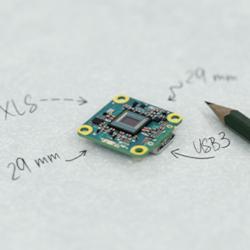PrecisionHawk Introduces PrecisionAnalytics – Agriculture, Delivering Aerial Insights and A.I. to Growers, Crop Consultants, Researchers, and Insurers
PrecisionHawk, Inc., a leading provider of drone technology for the enterprise, today announced PrecisionAnalytics Agriculture, an aerial mapping, modeling, and agronomy platform purpose-built for precision agriculture. Using PrecisionAnalytics, business leaders in agriculture can apply the latest generation of analytics tools and artificial intelligence (A.I.) to their aerial data, thereby automating plant inventory, size, and health analysis to help professionals more efficiently, accurately, and safely assess their fieldwork.
The largest source of drone operators in the world, PrecisionHawk has 150-plus full-time drone pilots and more than 15,000 drone service providers in their drone pilot network. The company’s clients are using the expansive operator network to capture data over millions of acres of land. PrecisionHawk is also one of the only UAV services companies that can fly BVLOS – dramatically increasing the average amount of data that be captured per mission.
“By working closely with leading agriculture enterprises for nearly a decade, we have learned a tremendous amount about what they need to be successful. Our customers have consistently told us that they need a more efficient way to scout their crops and analyze plant and livestock data. PrecisionAnalytics is that solution — applying advanced A.I. and machine learning to address the complexities of agriculture,” said Michael Chasen, CEO of PrecisionHawk.
PrecisionAnalytics — Agriculture in Farm Management
PrecisionAnalytics Agriculture is a powerful, but accessible, tool for turning aerial data into actionable intelligence. Using the software, farmers can process aerial data from multiple drone missions to identify and correct areas of concern before a planting season, during the growing season, or before harvest. Using machine learning models, the software features vegetative health indexing, plant and livestock counting, and canopy sizing, all of which can be tailored for specific crops and use cases. Farmers can aggregate these measures into custom zones and plots before exporting prescription maps and other data sets into farm management systems. Ultimately, the technology is empowering a more accurate and holistic view of the farm.
PrecisionAnalytics — Agriculture in Crop Insurance
Crop insurers can use PrecisionAnalytics Agriculture to accelerate the crop claims cycle. According to Agri-Pulse, 334 million acres of farm land were covered by 1.1 million insurance policies in 2018. As crop insurers annually update policies, they can use the A.I.-driven models in PrecisionAnalytics to inventory crops and assess total value of the property. As the scale of crop coverage grows, so does the need for a means to quickly and effectively inspect crops for damage. With drones, insurance adjusters can now collect, process, and report precise data—up to thousands of acres in just one day—in a streamlined system.
PrecisionAnalytics Agriculture also provides machine learning models that help adjusters after a loss to automatically detect and quantify the extent of the damage, such as wind, hail and flood. This practice replaces inefficient and subjective assessments—often conducted manually by the adjuster from the bed of a truck—with data-rich reports that use precise aerial measurements.
Getting Started
Now available, PrecisionAnalytics Agriculture has been adopted and deployed across multiple agriculture enterprises. More information about the solution can be found https://www.precisionhawk.com/precisionanalytics-agriculture.
PrecisionHawk will debut PrecisionAnalytics at AUVSI Xponential, taking place April 29-May 2 at Chicago’s McCormick Place. PrecisionHawk will be located at booth 1026 and featured in several panel and speaking sessions, including the event’s main keynote, which will be delivered by CEO Michael Chasen. Media and analysts interested in speaking with the team may contact precisionhawk@10fold.com.
About PrecisionHawk
PrecisionHawk is a leading provider of drone technology for the enterprise. PrecisionHawk’s client list includes Fortune 500 companies and market leaders in 150 countries, spanning a range of industries, including agriculture, energy, insurance, government and construction. To date, PrecisionHawk has raised more than $100 million from leading venture capital firms including Third Point Ventures and Millennium Technology Value Partners, with strategic investments from enterprise customers and partners including Comcast Ventures, DuPont, Intel Capital, NTT Docomo, and Yamaha Motor. The company, founded in 2010, is privately held and headquartered in Raleigh, NC. More information about PrecisionHawk can be found at www.precisionhawk.com or on Twitter @PrecisionHawk.
Comments (0)
This post does not have any comments. Be the first to leave a comment below.
Featured Product


